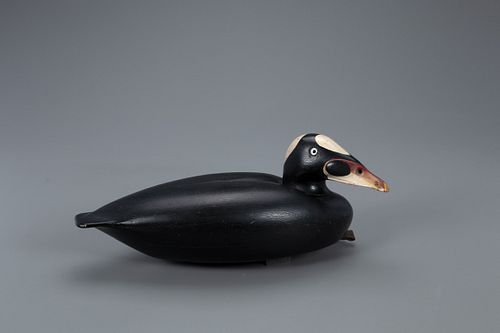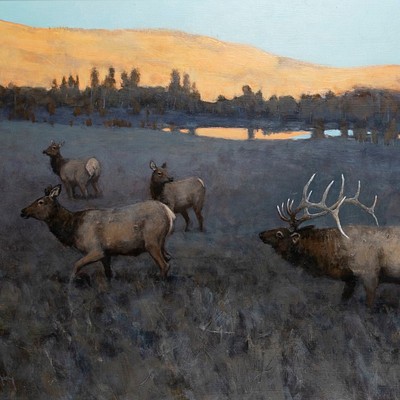Rare Surf Scoter Decoy, Charles E. "Shang" Wheeler (1872-1949)
Lot 176a
About Seller
Copley Fine Art Auctions
20 Winter Street
Pembroke, MA 02359
United States
Founded in 2005, Copley Fine Art Auctions is a boutique auction house specializing in antique decoys and American, sporting, and wildlife paintings. Over the course of the last two decades, the firm has set auction records for not only individual decoy makers, but also entire carving regions. Copley...Read more
Categories
Estimate:
$25,000 - $35,000
Absentee vs Live bid
Two ways to bid:
- Leave a max absentee bid and the platform will bid on your behalf up to your maximum bid during the live auction.
- Bid live during the auction and your bids will be submitted real-time to the auctioneer.
Bid Increments
| Price | Bid Increment |
|---|---|
| $0 | $50 |
| $1,000 | $100 |
| $2,500 | $250 |
| $5,000 | $500 |
| $10,000 | $1,000 |
| $25,000 | $2,500 |
| $50,000 | $5,000 |
About Auction
By Copley Fine Art Auctions
Jul 23, 2020
Set Reminder
2020-07-23 10:00:00
2020-07-23 10:00:00
America/New_York
Bidsquare
Bidsquare : The Sporting Sale 2020
https://www.bidsquare.com/auctions/copley/the-sporting-sale-2020-5244
Copley Fine Art Auctions The Sporting Sale 2020 Copley Fine Art Auctions cinnie@copleyart.com
Copley Fine Art Auctions The Sporting Sale 2020 Copley Fine Art Auctions cinnie@copleyart.com
- Lot Description
Rare Surf Scoter
Charles E. "Shang" Wheeler (1872-1949)
Stratford, CT, c. 1935
14 in. long
A hollow, turned-head decoy with elaborate carving that handsomely captures this distinct species. This sterling example that represents Wheeler at his finest. Scoter decoys by any maker are quite rare, with the vast majority of representations of the species stemming from Maine, Massachusetts, and Connecticut. Charles Edward Wheeler is widely recognized as the most famous bird carver from Connecticut. While his predecessors, Albert Laing (1811-1886) and Benjamin Holmes (1843-1912), made many gunning decoys of exceptional quality, it was Wheeler who took the art form to the next level, producing everything from sandhill cranes to sailfish. Shang, as everyone called him, was an enigmatic figure: oysterman, politician, boxer, cartoonist, public speaker, conservationist, and and world-renowned decoy carver.
Author Dixon Merkt comments on Wheeler’s life:
"Wheeler’s concern with the conservation of nature eventually led him into politics. Over the years he had come to know and admire Teddy Roosevelt, and as a politician he adopted Roosevelt’s brand of progressive Republicanism. Himself a skilled ornithologist, former cowboy, and avid sportsman, Roosevelt had made conservation one cornerstone of his political platform. Wheeler followed in his footsteps. During several terms in the Connecticut General Assembly, he led the campaign to pass anti-pollution and wildlife conservation legislation.
"...[Wheelers] His ties to Roosevelt and later to Herbert Hoover might have lead him to high government office, if that had been his goal. But Wheeler was satisfied with the life he had built for himself around Stratford. He had many good friends; his work kept him outdoors; and each year he had time for hunting and fishing trips."
In 1923 Wheeler arrived on the competition carving scene with a bang. Public concern over the popular and devastating practice of dusking (hunting after dark) had started to take shape. Led by conservationists, including early historian, author, and collector Joel Barber, along with Paul Bigelow and John Boyle, the group started the Anti-Duskers Society. The Anti-Duskers sponsored one of the first decoy shows in North America on August 23rd at the public library in Bellport, Long Island. A carving competition held at the event was aimed at hunters in attendance to further advance the concept of shooting over decoys. The inaugural event attracted amateur and professional carvers from near and far; however, it was Wheeler who took home top amateur honors with his dynamic turned-head mallard drake. Joel Barber gave the winning decoy the highest praise possible, lauding that it represented “the highest development yet reached in the American art of decoy carving.” As stated by Merkt, “Wheeler carted off first prize at Bellport because he had introduced a new style to decoy painting.”
Outstanding original paint with minimal wear.
Provenance: Private Collection, New York
Literature: Dixon MacD. Merkt, "Shang. A Biography of Charles E. Wheeler," Spanish Fork, UT, 1984, p. 80, Wheeler discussed, pp. 174-5, scoter decoys illustrated.Please email condition report requests to colin@copleyart.com. Any condition statement given is a courtesy to customers, Copley will not be held responsible for any errors or omissions. The absence of a condition statement does not imply that the lot is in perfect condition.Condition
- Shipping Info
-
Shipping info
Copley Fine Art Auctions does not handle the shipping of any items. Shipping is the sole responsibility of the buyer. Once your payment has cleared, and we have received your authorized shipping release form items may be released for shipment. Copley Fine Art Auctions, LLC shall have no liability for any loss or damage to such items. Buyers should allow up to four weeks for shipment.Please be aware that internet bidders may NOT not pick up their items at the sale. Items will be available for pick up by appointment or by shippers five days after the sale.
-



 EUR
EUR CAD
CAD AUD
AUD GBP
GBP MXN
MXN HKD
HKD CNY
CNY MYR
MYR SEK
SEK SGD
SGD CHF
CHF THB
THB














